Liturgical Calendar
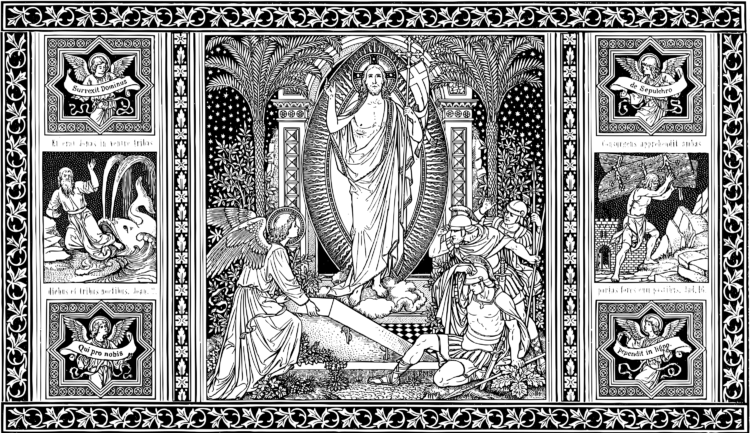
The Station is at St. John Lateran, on account of the important baptistry attached to this basilica.
In former times the Church held no special service on this day, but a meeting was held in the course of the afternoon for the last scrutiny of the catechumens, which almost immediately preceded the baptism; several ceremonies that still precede the conferring of baptism, were performed at this gathering.
At night was held the Watch or solemn Vigil of Easter, towards the end of which, before daybreak, the Catechumens plunged in the water of the baptistry were so to speak buried with Jesus; and at the very hour at which Christ rose triumphantly from the sepulcher they were born to the life of grace.
Later the great ceremonies were anticipated, being held first in the evening, and subsequently in the morning of Holy Saturday. They reveal a sudden change from sorrow to joy, and disclose certain anomalies which this notice helps to explain.
The Blessing of the New Fire
The Church, blessing as she does all elements of which she makes use for divine worship, made a practice of blessing every evening the new fire that was to provide the light for the office of Vespers. The liturgy of Holy Saturday maintains this custom. She also introduced later on the blessing of the five grains of incense which are to be fixed in the Paschal candle.
The altars are covered with linen cloths, but the candles are not lighted until the beginning of Mass. Meanwhile fire is struck from a flint outside the church and the coals are kindled. The priest vested in alb and violet stole, with or without a violet cope, accompanied by his ministers with processional cross, holy water, and incense goes outside the church door, if it can be conveniently done, or stands in the entrance of the church, and blesses the new fire.
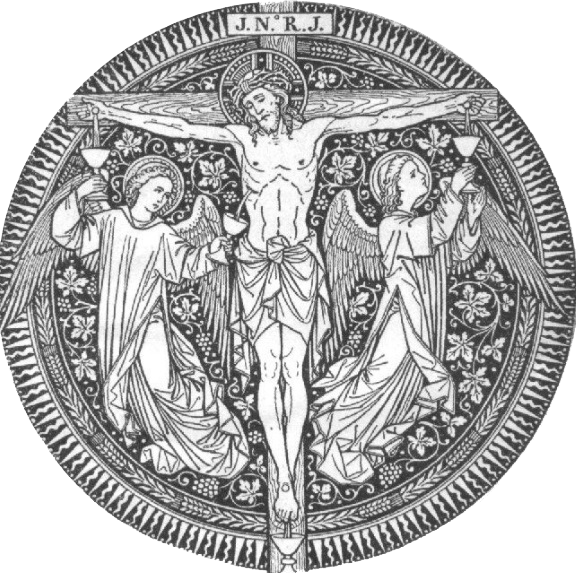
The Station is held at the basilica in Rome which represents Jerusalem. It is consecrated to the Passion of our Lord, and contains earth from Calvary, important fragments of the true Cross, and one of the nails.
On this day, the anniversary of our Savior’s death, the Church gives her temples an appearance of desolation an clothes her ministers in mourning.
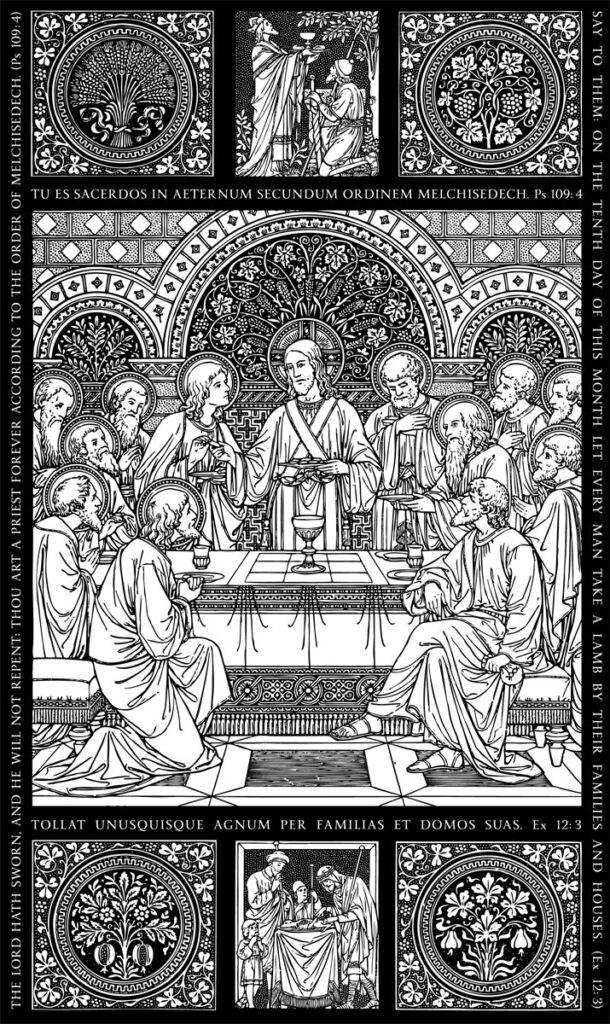
The Liturgy of Maundy (Holy) Thursday is full of memories of the Redemption. It provided formerly for the celebration of three Masses: the first for the reconciliation of public penitents, the second for the consecration of the holy oils, and the third for a special commemoration of the institution of the Holy Eucharist at the Last Supper. This last Mass is the only one that has been preserved, and at it the bishop, attended by twelve priests, seven deacons, and seven subdeacons, blesses the holy oils in his Cathedral church.
The Reconciliation of Public Penitents
The Church, endowed with the power of laying down the conditions necessary for the validity of the Sacrament of Penance, required in the fist centuries, that after open confession of sins of public notoriety, described by the Fathers of the Church as capital sins, the absolution should be preceded by the complete fulfilling of the satisfaction or penance. Hence the rite of the reconciliation of penitents, who on Maundy Thursday received the sacramental absolution of the sins for which they had done public penance during Lent. To this may be traced the Easter Confession following the forty days’ penance. In the beginning of the fourth century private penance came more largely into vogue, and this led gradually to the reversal of the practice aforesaid now in general use, the absolution being given immediately after the confession, and being followed by the performance of the penance imposed.
The Blessing of the Holy Oils
This blessing took place with a view to the baptism and confirmation of the Catechumens during Easter night.
The oil of the sick, which is the matter of the Sacrament of Extreme Unction, is blessed before the Pater.
The Holy Chrism which is the matter of the Sacrament of Confirmation, is the noblest of the holy oils, and the blessing of it takes place with greater pomp after the clergy have communicated. It is also used for the consecration of churches, altars and chalices, and in the baptism or blessing of bells.
The third holy oil, which is blessed immediately after, is that of the catechumens. It is used in the rite of baptism, at the ordination of priests, for the coronation of kings and queens, and with the Holy Chrism for the blessing of the font and consecration of altars.
Mass for Maundy Thursday
The Church today lays special stress on the institution of the Holy Eucharist and of the priesthood. This Mass carries out more than any other the command of Christ to His priests to renew the Last Supper, during which He instituted His immortal presence among us at the very moment His death was being plotted. The Church, setting aside her mourning today, celebrates the Holy Sacrifice with joy. The crucifix is covered with a white veil, her ministers are vested in white, and the bells are rung at the Gloria in excelsis.
After the Mass the altar is stripped in order to show that the Holy Sacrifice is interrupted and will not be offered up again to God until Holy Saturday. The priest therefore consecrates two hosts, for on Good Friday the Church refrains from renewing on the altar the sacrifice of Calvary.
Indulgences for Maundy Thursday
Pius VII granted a plenary indulgence to all who on Maundy Thursday perform some pious exercise (reading, meditation, or office) for one hour in commemoration of the institution of the Holy Eucharist, provided that, being truly contrite, they go to confession and Holy Communion on that day or on any day of the week following.
He also granted a plenary indulgence to all who pay a visit to the Blessed Sacrament at altars of repose on Maundy Thursday and Good Friday, and pray there for the intention of the Sovereign Pontiff, provided they have been to confession and that they go to Holy Communion on Maundy Thursday or on Easter Sunday.
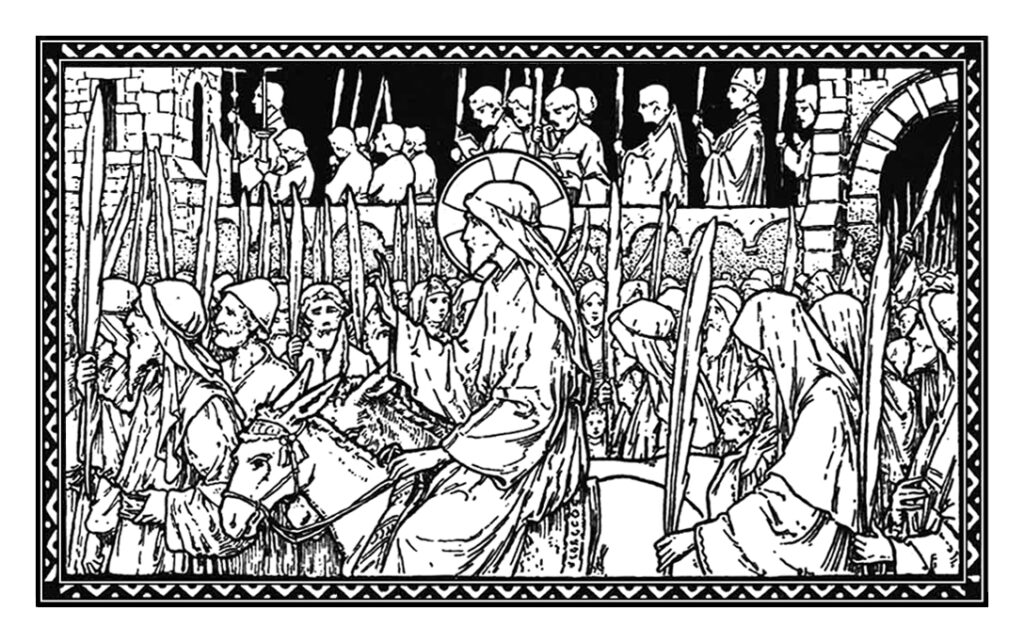
In today’s liturgy the twofold point of view from which the Church regards the Cross is expressed in two ceremonies, one marked by joy and the other by sadness, First comes the Blessing and Procession of Palms in which everything overflows with a holy joy which enables us after twenty centuries to revive the spirit of the magnificent scene of our Lord’s triumphal entry into Jerusalem. Then follows the Mass whose chants lessons relate exclusively to the sorrowful memory of our Redeemer’s Passion.
It is very important to recognize that our Lord preparing to come into Jerusalem, riding in on a donkey and the Passion (a foreshadowing of what is coming at the end of the week) go together. Christ rides triumphant into Jerusalem, though He has not yet conquered death. He comes now not so much to manifest His glory and power, as conquerors do, but rather to show us His humility by which He conquers.
The Blessing and Procession of Palms
At Jerusalem, in the fourth century, on the very spot where the event took place, was read the Gospel narrative in which we see Christ, hailed as King of Israel and taking possession of His capital, Jerusalem, which is really no more than the type of Jerusalem above. After this a bishop, mounted on an ass, rode up to the church of the Resurrection on the summit of the mount of Olives, surrounded by a multitude carrying palms and singing anthems and hymns. This ceremony was preceded by the reading of the passage from Exodus in which are mentioned the palm-trees, near the twelve foundations where Moses promised the manna: these were types of the coming Redemption, and of the sacraments of Baptism and Eucharist, by which the fruits of Redemption were to be applies to souls about Easter.
The Church of Rome, it would seem, adopted this practice about the ninth century and added to it the rite for the Blessing of the Palms. This blessing took place at St. Mary Major, from where the procession went to the stational church of St. John Lateran. In this benediction, the Church prays for health of mind and body for those who dwell in houses where the palms are preserved. The Church adds that the branches of palms signify Jesus’ triumphs over the prince of death and the branches of olives proclaim, in a manner, the coming of spiritual unction.
This procession of Christians, who with palm in hand and songs of Hosanna on their lips, proclaim Christ’s Kingship every year, throughout the whole world and in all generations, is composed of all catechumens, of public penitents, and of the faithful, who at the Easter Feast will go forth to meet our glorious Victor through the sacraments of Baptism, Eucharist, and Penance.
At the door of the Church, some members of the choir have already gone in, and they chant alternately with the clergy the “Gloria laus”: on the one side “the angelic choir”, and on the other Christ’s soldiers, still plunged in the strife of battle. The door opens after the subdeacon has knocked on it three times with the foot of the cross; so does the cross of Christ open heaven to us.
We should keep a blessed palm carefully in our home. It is a sacramental which will obtain for us graces in virtues of the Church’s prayer. Fixed to a Crucifix, it reminds us of Christ’s victory on the Cross.
There is another feast of the Seven Sorrows of Our Lady on September the 15th. The feast fixed on this Friday in Passion week shows us the divine Mother at the foot of the Cross where Christ is dying (Introit, Sequence, Gospel). “An ineffable union is established between the oblation of the Incarnate Word and that of Mary; the divine blood and the tears of the Mother flow together and are mixed for the redemption of the human race.”
As Judith had delivered Israel by killing Holofernes (Epistle), the Blessed Virgin is our deliverer with Jesus.
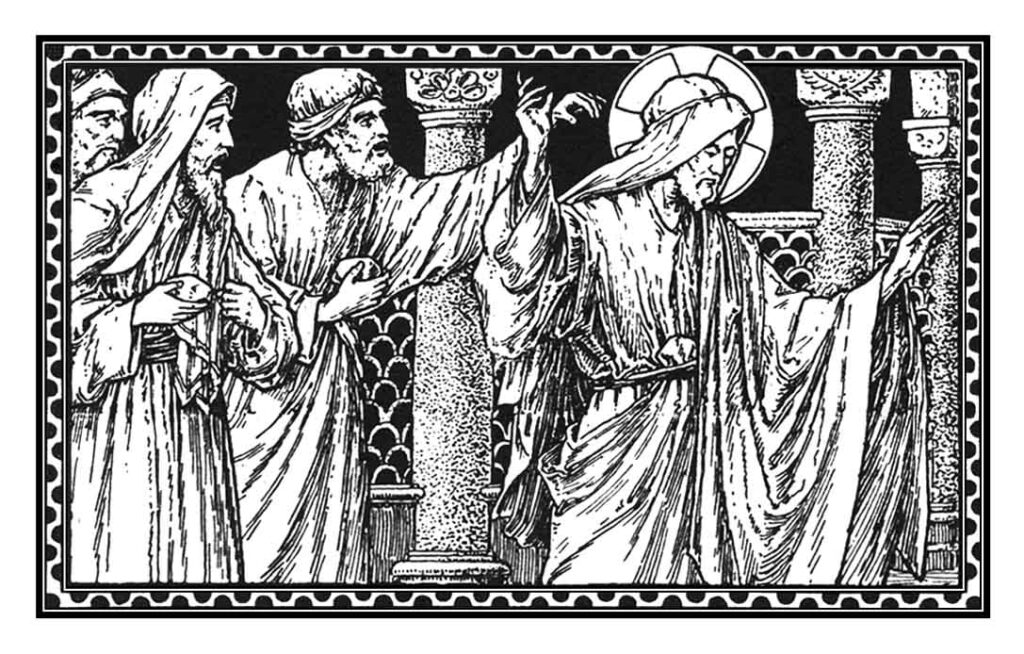
In the Introit, Gradual, and Tract, the Psalmist, exiled among hostile people, represents Christ “against whom rose up an angry nation.”
The Gospel shows us the growing hatred of the Sanhedrim. Abraham believed the divine promises which heralded the Messias, and in limbo his soul rejoiced to see them now fulfilled. But those, who ought to have recognized in Jesus the Son of God, greater than Abraham and the Prophets, misunderstood the meaning of His words. They insulted the Messias and tried to stone Him.
St. Paul tells us that Jesus Christ is the Pontiff and the Mediator of the New Testament. In the same way as the High Priest once entered the Holy of Holies with the blood of the victims, so, in a far more excellent way, Christ entered into heaven, the true Holy of Holies, to offer to His Father the blood He shed for us (Epistle).
Until Maundy Thursday, in Masses of the Season, the Psalm Judica me, and Gloria Patri at the Introit and after the Lavabo are emitted.
-St. Andrew Daily Missal
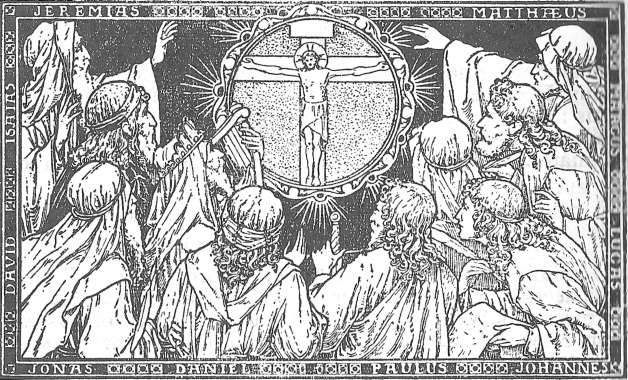
Doctrinal Note
The hatred of Christ’s enemies grows day by day. It is about to break out, and on Good Friday, we shall be reminded of the most frightful of all crimes, the bloody drama of Calvary, foretold by the prophets and by our Lord Himself. The liturgy, too, taking into account both the Old and New Testaments, works out a striking parallel between the teaching of St. Paul and the Evangelists about our Lord’s Passion and the clear prophecies of Jeremias. Isaias, David, Jonas, and Daniel (see illustration).
As the fatal end approaches, the Church’s accents of grief become more and more penetrated with feeling. The thunderbolt of divine Justice is about to strike the Redeemer who has become man for love of His Father and for us. By reason of the mysterious solidarity between all the members of the great human family, He offers Himself as a substitute for His guilty brethren. As the prophet says: “He clothes Himself with our sins as with a garment,” and He was “made sin for us1” that He might bear our sins in His body upon the tree2 and destroy it by His death. In the Garden of Gethsemane, the sins of every age and of all mankind flowed horrible and repulsive into the most pure soul of Jesus. Further, the Father doing violence to the love He bore Him is to treat Him as a being accursed, according the the scripture: “Cursed is He that hangs upon a tree3.”
For “the work of our redemption required4” that our Lord should be set as the salvation of the world upon a cross, so that “whence came death, thence might life be restored, and that He who overcame by a tree, might also on a tree be overcome5.” It is an unequal struggle between the Prince of life and that of death6, but Christ triumphs in the very act of His self-immolation7. Already on Palm Sunday, He advances like a conqueror, sure of Himself, greeted with acclamations and already crowned with palms and laurels “tokens of the victory which He is about to win8.”
Jesus enters His capital Jerusalem, and mounts the costly throne which His Blood “adorns with royal purple9“, over which Jews and Romans write in the three principal languages of the time, “Jesus of Nazareth, the King of the Jews.” David’s prophecy is accomplished” God is reigning from the tree10, which from being an object of shame becomes a “standard of the King11,” and our “only hope” on this “holy Passion day12.” “We adore Thy Cross, O Lord…for behold, by the wood of the Cross, joy came into the whole world13.” It was to show clearly how, from this point of view, the Church regards our Lord upon the cross, that in days gone by Christian artists changed His crown of thorns into one, heraldic and royal.
It was at the end of Lent, when the Church makes remembrance of the death and triumph of Christ, that the ancient councils required that the sacraments of Baptism, Confirmation, and the Eucharist should be given to the catechumens and that public penitents should be reconciled by sacramental absolution. In a sense these catechumens were “buried together” with Christ by baptism into death and rose with Him into newness of life14 So do Passiontide and Easter, by marking for all Christians the anniversary of the reception of those blessings, remind them that our Lord’s Passion and Resurrection were at once the efficient cause and the pattern of their own, and help them as the years pass, to share in these sacred mysteries in an ever more full and intimate way.
These feasts were not, the, a mere commemoration, concerned only with our Lord Himself; they became a reality for His whole mystical body. The conflict of Calvary extended to the whole world where with Christ her Head, the Church gained a new victory over Satan every year at the Easter Feast.
The purpose of Passiontide through its close connection Easter, is to recall to us the memory of our Baptism, when our souls were washed in our Lord’s Blood, and of our First Communion when they drank of its healing stream15. By the Easter Communion and Confession, survivals of the ancient discipline connected with Baptism and Penance, we are led at this liturgical season to die and rise once more with Christ.
- 2 Corinthians 5:21
- 1 St. Peter 2:24
- Galatians 2:13
- Hymn at morning service Good Friday
- Preface of the Cross
- Easter Sequence
- Pange Lingua
- Prayer at the Blessing of Palms
- Vexilla Regis
- Ibid.
- Ibid.
- Ibid.
- Adoration of the Cross on Good Friday
- Romans 6:4-11
- The Fathers tell us that from our Lord’s open side “there came out blood and water” (St. John XIX, 34) symbols of Baptism and the Eucharist.
Historical Note
While the purpose of Passiontide is to call to our minds the persecutions of which our Lord was the object during His public life , it is concerned more especially, with the last year of His ministry. Then it was that the hatred of His enemies which increased daily began to reveal itself in more tangible form, culminating in the drama which the Church reproduces in Holy Week, when day by day she follows the footsteps of her Lord.
The second year: After having restored to life the son of the widow of Naim, our Lord absolves Mary Magdalen, the woman who was a sinner but who did not fear to come and throw herself at His feet while He reclined at the table of Simon the Pharisee. Judas’ avarice foreshadows his crime1.
The third year: After the Transfiguration, Jesus returns to Capharnaum, immediately afterwards making the pilgrimage to Jerusalem for the Feast of Tabernacles2. He proclaims Himself the Fountain of living water, refreshing the souls of men and foretells His approaching death3. When the festivities are over He gives proofs of His Divinity to the Jews who in consequence try to stone Him4, for is not He a blasphemer who claims to be one with the Father in heaven5. Subsequently going into Perea, our Lord is called from thence to Bethany, where He raises Lazarus from the dead; a miracle which wins Him such renown that the Jews, no longer able to contain their jealous hatred, definitely decide upon His death. Our Lord therefore, takes refuge at Ephrem6, returning six days before the Passover to Bethany where, “for His burial,” Mary Magdalen pours a precious ointment over His feet7.
The Great Week. The next day Jesus makes His triumphal entry into Jerusalem8. The same evening He leaves the town returning the next day, i.e., the Monday in Holy Week, when He receives certain Gentiles in the Temple9. On the Wednesday evening He goes towards the Mount of Olives, foretelling to His disciples His Passion, now close at hand. He does not return to Jerusalem until the Thursday evening for the Last Supper10; is crucified the next day on Calvary at the city gates11; is buried the same day in the sepulcher from whence He issues triumphant on the Sunday morning12.
- Thursday in Passion week.
- Tuesday in Passion week.
- Monday in Passion week.
- Passion Sunday.
- Wednesday in Passion week.
- Friday in Passion week.
- Monday in Holy week.
- Gospel for the Blessing of the Palms.
- Saturday in Passion week.
- Maundy Thursday.
- Palm Sunday.
- Holy Saturday.
Liturgical Note
The Septuagesima season forms a remote preparation for Easter and Lent a proximate one; its last two weeks known as Passiontide, being an immediate preparation for the Feast.
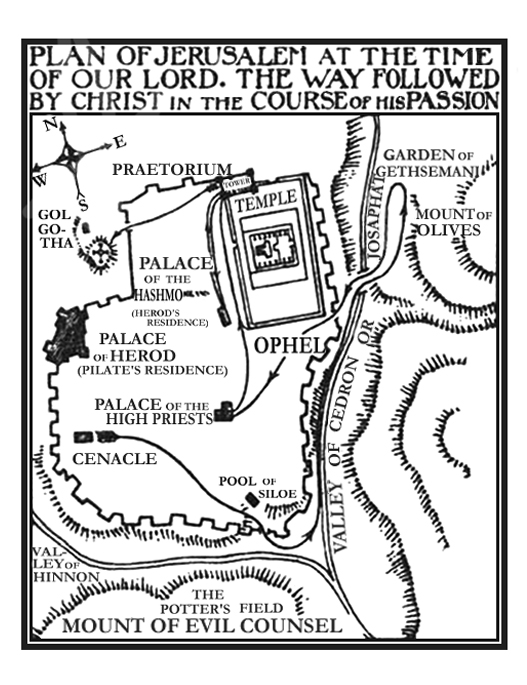
The celebrations and ceremonies of the last week, known as the Great Week or Holy Week, have their origin in the Church at Jerusalem. There, with the Holy Gospels in hand, the Christians would follow their Redeemer step by step, piously gathering on the very spot precious souvenirs of the most solemn among all events, that which marked the close of His mortal life.
These celebrations, at first local in character, were adopted into the liturgy at Rome, where the very churches were planned in such a manner, as to make it possible to carry out the offices of Holy Week in the way that had been customary at Jerusalem. The last three days are called the Sacred Triduum. During this fortnight the Church suppresses the psalm Judica and in several instances the Gloria Patri also, since these had no place in the ancient Liturgy. Moreover, she veils all pictures and statues.
With regard to this, certainly devotion to the saints should yield before the great work of Redemption, but when it is observed that the crucifix itself is veiled, we see here a trace of the custom which obtained of suspending a curtain between the sanctuary and the nave, during the whole of Lent. In those times public penitents who had been excluded from the Church could not enter it again until Holy Thursday, and when this custom was abolished, all Christians were more or less placed in the position of such penitents. Although no sentence of exclusion was pronounced against them, the sanctuary and all that took place there was hidden from them, to show that they could only merit the share in Eucharistic worship given them in their Easter Communion, after they had brought forth fruits worthy of penance.
Finally, by stripping the altars and silencing all organs and bells on Holy Thursday, Good Friday, and Holy Saturday, the Church gives expression to the grief which she feels at the memory of the death of her divine Spouse.
-St. Andrew Daily Missal
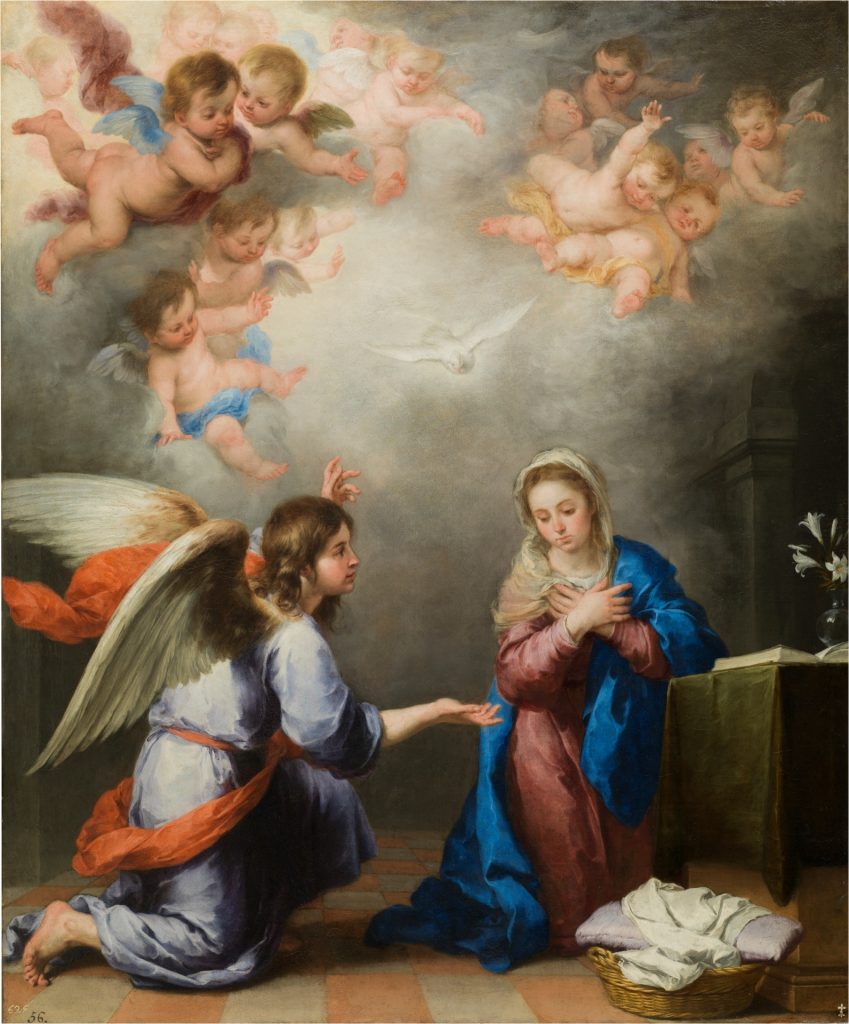
“Hail full of grace, the Lord is with Thee.” The Feast of the Annunciation of the Blessed Virgin Mary commemorates the most important event in human history, the Incarnation of Our Lord (Gospel) in the womb of a Virgin (Epistle). Today is the day on which the Archangel Gabriel came from Heaven with the Gospel, the good news from Heaven, that God would become man to save the world from sin and death and an eternity separated from the love of God.
On this day the Word was made flesh, and united to itself forever the humanity of Jesus. March 25 is indeed the anniversary of the ordination of Christ as priest, for it is by the anointing of the divinity that He has become the Supreme Pontiff, Mediator between God and man. The mystery of the incarnation has earned for Mary her most glorious title, that of “Mother of God” (Collect). “Standing on the threshold of divinity” since she gave to the Word of God the flesh to which he was hypostatically united, the Virgin has always been honored by a supereminent worship, that of hyperdulia.
To March 25 will correspond, nine months later, December 25, the day on which will be manifested to the world the miracle as yet only known to heaven and to the humble Virgin.
The reversal of the punishments leveled against Adam and Eve and the entire human race after the fall was initiated today with those most famous words from St. Luke’s Gospel—”Hail full of grace, the Lord is with thee. Blessed art thou among women.”
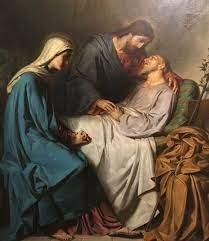
Due to Laetare Sunday, this year’s feast is transferred from March 19 to March 20.
The Church always honors St. Joseph with Mary and Jesus, especially during the Christmas solemnities. This day’s Gospel is indeed that of December 24. Since the end of the fifteenth century this feast is kept on March 19: this day according to a tradition, is the anniversary of his holy death. Veneration of St. Joseph is of relatively recent introduction in the Church’s liturgy. In 1621, Gregory XV extended the feast to the whole Church. In 1870, Pius IX proclaimed St. Joseph as protector of the universal Church and instituted a second feast, called his “Patronage” and since 1912 his “Solemnity.” Pope John XXIII added St. Joseph’s name to the Canon of the Mass in 1960, the first addition made to the Canon in over a thousand years.
This saint of “the royal race of David” was a just man (Gospel). As by this marriage with the Blessed Virgin, St. Joseph has certain rights over the virginal womb of his spouse, a moral affinity exists between him and Jesus. He exercised over the Child-God a certain paternal authority, which the Preface of St. Joseph delicately alludes to as that of a foster-father. He therefore deserves a special worship.
“Christ and the Virgin were with him at his last hour and watched by him their faces gleaming with sweet serenity.” St. Joseph went to heaven for ever to enjoy the beatific vision of the Word whose humanity he had so long and so closely contemplated on earth. This saint is therefore justly considered the patron of the dying and the model of contemplative souls.
St. Joseph, husband of the Blessed Virgin Mary and foster-father of our Lord, faithfully and humbly carried out the difficult and glorious mission entrusted to him by God and thus became the model of domestic virtues and humble daily toil, the guardian of chaste souls and the protector of Christian homes.
O Saint Joseph, whose protection is so great, so strong, so prompt before the Throne of God, I place in you all my interests and desires. O Saint Joseph, do assist me by thy powerful intercession, and obtain for me from your Divine Son all spiritual blessings through Jesus Christ, Our Lord; so that, having engaged here below your Heavenly power, I may offer my Thanksgiving and Homage to the most Loving of Fathers. O Saint Joseph, I never weary contemplating you and Jesus asleep in your arms. I dare not approach while He reposes near your heart. Press Him in my name and kiss His fine Head for me, and ask Him to return the Kiss when I draw my dying breath. Saint Joseph, patron of departing souls, pray for us. Amen.
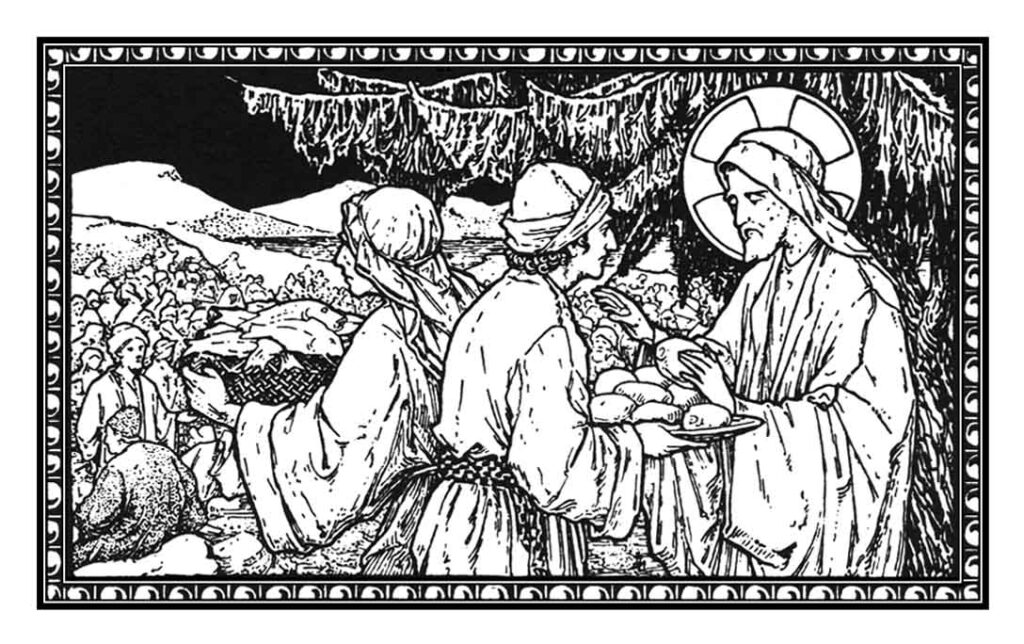
Mid-Lent or Laetare Sunday is a halting place in the midst of Lenten observance. Therefore, dalmatic and tunicle are worn, the altar is decorated with flowers, the organ is being played at Mass and Vespers even for voluntaries. There are flowers on the altar shelves. Rose vestments (derived from the blessing of the golden rose, which the Pope performs sometimes on that day), instead of violet, may be used.
The liturgy today tells us to rejoice. The texts of the liturgy also tell us to rejoice. Introit, Epistle, Tract, and Communion allude to Jerusalem, on the occasion of the Stational Church—the Church of the Holy Cross in Jerusalem. More specifically, the introit tells us, “Rejoice, o Jerusalem, and come together all you that love her. Rejoice with joy, you who have been in sorrow.” The gradual also tells us, ”I rejoiced, because they said to me, ‘We will go up to the house of the Lord.’” Joy is the theme of the liturgy today. So in order for us to understand this theme, we must understand what joy is. Summarizing St. Thomas’ definition, we can say that joy is that movement of the soul which arises from possessing what is good.
The Gospel tells us of the miracle of the multiplication of loaves and fishes, symbols of the Eucharist which we shall receive in our Easter Communion, and the Epistle tells of our deliverance through the sacraments of Baptism and Confession.
The two sons of Abraham (Epistle) symbolize the two Testaments: Ismael, son of Agar, represents the Jews as slaves to the Mosaic law, whilst Isaac, son of Sara, represents the Gentiles whose faith makes them heirs of the promise.
"Listen carefully, my son, to the master's instructions, and attend to them with the ear of your heart. This is advice from a father who loves you: welcome it, and faithfully put it into practice"
~ St. Benedict of Nursia ~
Copyright © 2015-2025 Saint Joseph Catholic Church, Latin Mass Parish, 602 S 34th St., Tacoma, WA 98418. All Rights Reserved.
Website comments or questions: info@saintjosephtacoma.org


